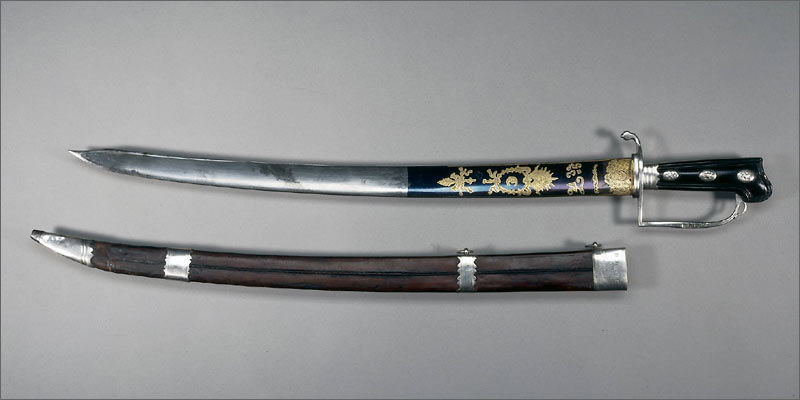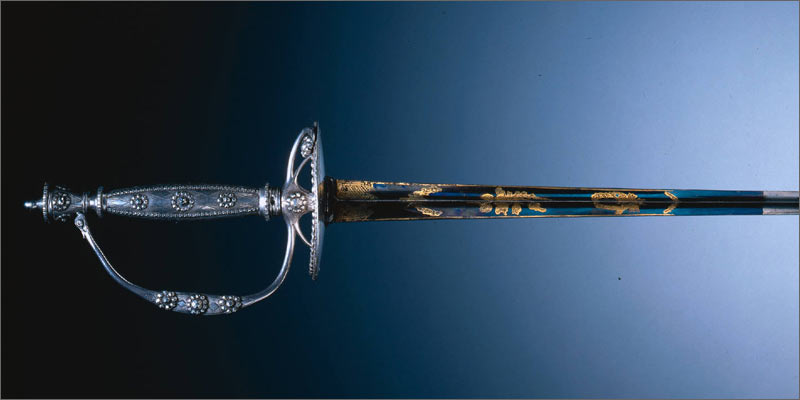| Author |
Message |
Ed T.

|
 Posted: Thu 21 Aug, 2008 12:51 pm Post subject: First Sword Commission - Type XVI Riding Sword Posted: Thu 21 Aug, 2008 12:51 pm Post subject: First Sword Commission - Type XVI Riding Sword |
 |
|
I would like to explore the possibility of commissioning a special sword. It would be a replica of a fictional 14th century riding sword. Details regarding the "fictional" history can be found here. I'm starting a new thread in order to determine the feasibility of having this sword made. I am new to the medieval sword hobby so I lack the experience to know where to begin such a project. Obviously the is no lack of experience in this forum so I anticipate receiving excellent advise.
The type of sword I would like to commission would be taken from an actual sword once owned by Ewart Oakeshott. It was a small riding sword (21" blade) categorized as type XVI.

The significant differences between the actual sword and my commission would number three.
1. The cross would look like the one seen below.

2. The blade would be blued, the color could be described as "Peacock Blue".
3. Inscriptions would be engraved in the fuller on both sides of the sword. A cross on one side and the letters "BOAC"* on the other.
My biggest concern is the "peacock blue" blade. Was this actually done to enhance the appeal of swords in the 14th century. If so what were the advantages/disadvantages of blueing the blade vs. the typical presentation of a steel blade? Since I have been unable to find any pictures of such a blade I must assume it was not a common practice. My goal is to follow the description/design that author Michael Jecks has put forth for the sword but only if it passes the "historic feasibility" test. If you have any opinions and/or documentation I'd love to hear from you.
If the project progresses beyond feasibility I would need to find a bladesmith to work with (again, suggestions please) and get an endorsement from Mr. Jecks, who has indicated interest.
So there you have it, my first foray into custom sword creation. May God and the *Beati Omnipotensque Angeli Christi (blessed and omnipotent angels of Christ) help me. 
Ed Thyberg
|
|
  |
 |
|
Jeremy V. Krause
|
 Posted: Thu 21 Aug, 2008 1:45 pm Post subject: Posted: Thu 21 Aug, 2008 1:45 pm Post subject: |
 |
|
Hi Ed,
Antique swords described as having a "blue" blade (the fine Xa.1 from Records comes to mind) receive this characteristic from the patina received through the chemical/mineral composition mud they were held in for so long. There is no evidence that historical blades would have been created to have this effect.
Modern knife makers often create beautiful and striking colors on their knives and I imagine this could be done to a sword but it would not be historical in my opinion.
Hope this helps,
Jeremy
|
|
  |
 |
Nathan Robinson
myArmoury Admin


|
 Posted: Thu 21 Aug, 2008 2:43 pm Post subject: Posted: Thu 21 Aug, 2008 2:43 pm Post subject: |
 |
|
| Jeremy V. Krause wrote: | | There is no evidence that historical blades would have been created to have this effect. |
Unfortunately, your statement is much too wide-sweeping to be accurate. Many, many sword blades from the historical record can be found having bluing effects. Having said that, it must be noted that a great majority of these items are from a later period than is being discussed here.
Please note these examples.
 Attachment: 30.6 KB Attachment: 30.6 KB

Hunting Sword, circa 1778-1779
 Attachment: 28.75 KB Attachment: 28.75 KB

Court sword, circa 1790
 Attachment: 37.02 KB Attachment: 37.02 KB

Hunting sword, France blade-possibly-German) , circa 1780
.:. Visit my Collection Gallery :: View my Reading List :: View my Wish List :: See Pages I Like :: Find me on Facebook .:.
|
|
    |
 |
|
Jeremy V. Krause
|
 Posted: Thu 21 Aug, 2008 3:54 pm Post subject: Posted: Thu 21 Aug, 2008 3:54 pm Post subject: |
 |
|
Yes Nathan,
I did think about editing my post to point toward the swords of the early 16th and later examples, but I felt it might confuse the original question and the direction of the line of inquiry. These beautiful examples you show demonstrate a type of decorative blueing along with gilding on the upper 1/3rd of the blade and are not on the business end. Also I am uncertain if these examples employ blueing on the cutting edge.
Swords prior to 1400 have shown no evidence of purposeful "blueing" though and I really don't believe that the "blue, purple" seen on older blades is related to the "blueing" on later pieces.
In short- you are absolutely right- but maybe this question could be confused by such references,
Jeremy
|
|
  |
 |
Ed T.

|
 Posted: Sat 23 Aug, 2008 3:02 pm Post subject: Posted: Sat 23 Aug, 2008 3:02 pm Post subject: |
 |
|
Jeremy and Nathan,
Thanks for your thoughtful replies.
Perhaps someone could educate me on how steel is blued. Putting aside the lack of evidence for a moment, would it have been possible for a 14th century armourer to have created a peacock blue sword blade? Would it be done by only heating and cooling or would chemicals be applied to the steel? Would the process of bluing change the hardness and/or brittleness of the steel? I believe there are some rust inhibiting benefits of blueing steel, hence its use on armour. Anybody have an opinion?
Ed Thyberg
|
|
  |
 |
|
Jonathan Hopkins
|
 Posted: Sat 23 Aug, 2008 3:11 pm Post subject: Posted: Sat 23 Aug, 2008 3:11 pm Post subject: |
 |
|
I am not familiar with the technicalities of the bluing process used on the 18th century swords Nathan posted, however I do know that mercury. The process was discontinued in Britain by the 1820s-30s, and in Germany at some later point in the 19th century (1880s-90s maybe?). I am not sure how safe the process is and if anyone is willing or able to reproduce this type of bluing, or if there are other means to obtain this color.
Jonathan
|
|
  |
 |
|
|

